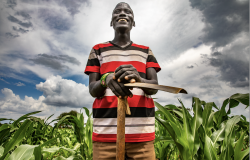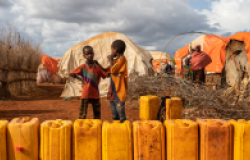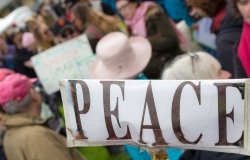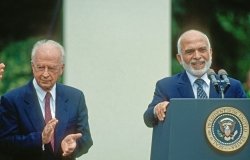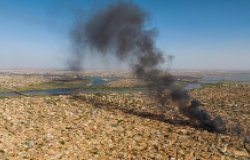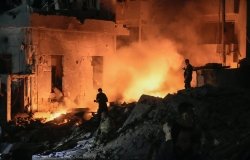Kennan Cable No. 75: Victory, Defeat, and Russian Ways in War
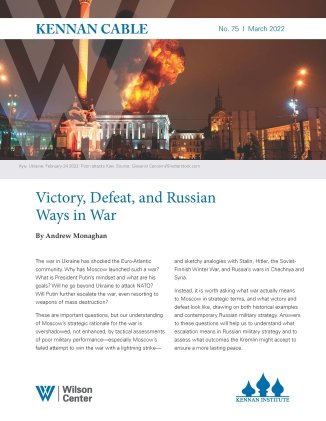

The war in Ukraine has shocked the Euro-Atlantic community. Why has Moscow launched such a war? What is President Putin’s mindset and what are his goals? Will he go beyond Ukraine to attack NATO? Will Putin further escalate the war, even resorting to weapons of mass destruction?
These are important questions, but our understanding of Moscow’s strategic rationale for the war is overshadowed, not enhanced, by tactical assessments of poor military performance—especially Moscow’s failed attempt to win the war with a lightning strike—and sketchy analogies with Stalin, Hitler, the Soviet-Finnish Winter War, and Russia’s wars in Chechnya and Syria.
Instead, it is worth asking what war actually means to Moscow in strategic terms, and what victory and defeat look like, drawing on both historical examples and contemporary Russian military strategy. Answers to these questions will help us to understand what escalation means in Russian military strategy and to assess what outcomes the Kremlin might accept to ensure a more lasting peace.
Indeed, this is the challenge for policymakers across the Euro-Atlantic community. Since Moscow’s use of the military is the reflection of the continuation of policy, the Russian leadership may be prepared to accept considerable costs, including heavy casualties, if its policy goals remain achievable. Equally, if Washington, London, and their allies across NATO are successful in supporting Ukraine’s sovereignty such that Kyiv is able to force a stalemate or even achieve a military victory, a protraction of the policy clash between Moscow and Kyiv and the eruption of war at a later date are both probable. Moreover, actions that appear to seek Moscow’s complete defeat could turn the situation to an existential challenge for the Russian leadership, with escalatory consequences.
Russia’s Measures Short of War?
Part of the shock caused by the attack on Ukraine is because of what appears to be a dramatic shift in how the Russian leadership is acting. It is not just the scale of the fighting in Ukraine, but that the fact that the attack has happened at all. This is in large part because of how Western strategists assessed the modern Russian way of war.
Following Russia’s annexation of Crimea and subsequent fighting in eastern Ukraine in 2014, many in the Euro-Atlantic community believed that Moscow prioritized the use of proxies and private military companies, propaganda and disinformation, and cyberattacks and political subversion. Despite Moscow’s use of armed force in combat in 2015 (for instance, in the decisive battle of Debaltseve) and then in the Syrian civil war, Western attention focused on Russia’s measures short of war. Russia’s new way of war was believed to accentuate asymmetry and ambiguity, relegating traditional combat power to a minor role, if one at all.
But throughout the 2010s, policy discussion in Moscow emphasized intensifying geo-economic competition, the growing use of force in international affairs, and the possibility of war. Indeed, the Russian military leadership emphasized the continuing, even growing, significance of the armed forces,[1] and oversaw an extensive re-equipment, modernization, and reorganization process.
Moscow reshaped Russia’s defense and security landscape, establishing the National Defense Management Centre in 2014, the Aerospace Forces in 2015, and Rosgvardia in 2016. Extensive exercises rehearsed long-distance deployments across the country, along with command and control, including between civilian and military authorities, and logistics. By 2017, Russian officials were highlighting their ability to deploy force groupings to strategically important parts of the world. In 2019, the Russian military leadership re-emphasized its view that warfare was becoming more dynamic, with “short and fast-flowing military action with no time for correcting mistakes.”[2] Far from measures short of war, therefore, Moscow has long envisaged and prepared for measures of war as part of its wider grand strategy.
What is War to the Russian Leadership?
The Russian leadership uses the phrase “special military operations,” deliberately avoiding the term war to describe the situation in Ukraine.[3] But understanding how Moscow defines war can help us to frame the current situation, both in terms of forces used and possible escalation.
In official terms, Moscow is explicit about what it understands by war: it is when a state turns to the use of armed force to resolve a policy clash.[4] The Russian military has much more to say about it, defining not just generations of wars, but also periods in each war. These go from the emergence of the period of imminent threat prior to the outbreak of war into its potentially decisive initial period (until the achievement of the first, critical military objectives, perhaps lasting up to two weeks) through following period(s) to its concluding period.
The military also defines levels of war. These include
- Local war: a war pursuing “limited military-political objectives”, when military action takes place “within the borders of the warring states”, affecting the territorial, economic, political, and other interests of these states.
- Regional war: a war involving “several states in the same region”, waged by national or coalition armed forces in the course of which the sides are pursuing “important military-political objectives”.
- Large-scale war: a war between coalitions of states or major states of the world community in which the sides are pursuing “radical military-political objectives”. A large-scale war may result from an escalation of a local or regional war and involve a significant number of states from different regions of the world. It requires the “mobilization of all physical resources available and the spiritual strength of the participating states”.[5]
These definitions do not describe the scale of the fighting: any of these levels could fall under what would be defined in the U.S. as large-scale combat operations. But they do give an indication of the kinds of aims and weapons used in different cases. In a local war, for example, conventional general forces are used for essentially limited political ends; strategic capabilities come into play in a large-scale war, with more drastic political consequences.
Understanding war as a policy clash means that defining success and failure is relatively easy: Victory is the achievement, by one of the sides, of the political and military strategic aims of the war. The Russian military states that “the direct result of victory is the cessation of military activity on the conditions of the victor, formalized by an international legal document.” The main characteristics of victory at a military level include the destruction of the enemy’s armed forces and the occupation of the most important parts or all of its territory. It can also mean the collapse of economic potential, disorganization of political structures, and the loss of the moral ability to continue to resist on the part of the population and armed forces. The source of victory, according to the Russian Ministry of Defense, is the “concentrated combination of all material and spiritual capabilities of the state and effectiveness of their use as expressed in military power.”[6] This, of course, also provides clarity on how the Russian military views defeat (porazhenie).[7]
Russian military experts have sketched out a spectrum from victory to defeat. If a policy clash defines the context of the war and the initiation of hostilities, this spectrum tracks possible characteristics of success and failure, from the highest stages of success (political victory), and then military victory through to military defeat and finally to complete destruction (political defeat).[8] Though it is an essential characteristic of war, therefore, success or failure of military activity remains secondary to the political results of the fighting.
Indeed, the spectrum highlights the fact that military victory (or defeat) on its own is insufficient. Though one side may lose the war militarily, statecraft can mitigate the consequences of military defeat, even overturning it. Moreover, while one side may be militarily defeated in a war, if the policy conflict remains unresolved, war may erupt again, with the initial result subsequently reversed. The ambition of political victory is the permanent resolution of the policy conflict, with documented agreement, ruling out subsequent wars.
Ways in War And How to Achieve Victory?
War is a strategic activity, therefore, guided by political aims and incorporating diplomatic and economic measures prior to the war and during it. In Russia, the military’s role in achieving victory is the subject of much debate between advocates of offensive strategies of destruction, the “one-blow,” short war, and advocates of longer “strategies of attrition.”
Russian military thought has long prioritized the offensive, attempting to win the war at the strategic and operational levels, rather than at the tactical. The main emphasis has been on seeking strategic and operational surprise to seize the initiative and wage operations deep into an enemy’s territory. This is intended to cause paralysis in the adversary’s decision-making, destroy the first echelon of enemy combat forces, disrupt enemy mobilization, and destroy vital power centers.
Russian military experts focus on the ideal of achieving a decisive combination of surprise with a sufficiently heavy initial blow and sustaining the initiative through uninterrupted activity. Speed offers victory, while interruption, pauses, or delay invite ceding the initiative to the adversary: this is what underpins the Russian view of lightening war (molnienosnaya voina). Plans to achieve lightning victories have underpinned most Russian offensive operations in the modern era. Moscow achieved success in such one-blow wars against Japan in Manchuria in 1945 and Czechoslovakia in 1968.
But this approach has long had its critics in Russia, who have argued that it limits the concept of the offensive only to military action, when war should also be waged using political means and economic measures. A longer, attritional war can also lead to conclusive effects and the attainment of political goals through a deliberate process of exhausting the enemy. Indeed, unless the enemy is weak and characterized by internal political conflict, then a single decisive strike is unlikely to lead to victory: only a longer, more substantial effort will suffice.
In any case, the character and duration of a war is the result of specific political, economic, and military conditions. And in practice, the difficulty of foreseeing the changing character of future war means that Russian military strategists tend to hedge their bets between destruction and attrition, with the intent (at least in theory) to conduct quick, decisive strikes often being balanced by practical preparation for a longer, more attritional fight.[9]
What Are the Characteristics of Defeat?
Russia has been defeated in war on several occasions in the modern era. Defeated militarily in the Russo-Japanese and Soviet-Polish wars, for instance, Moscow sued for peace—but through subsequent diplomacy and statecraft first mitigated the immediate consequences of defeat and, over the longer term (through to 1945), returned to war to resolve them. World War I is the primary example of Russia’s complete strategic defeat in the modern era, a point often acknowledged by the Russian leadership itself,[10] with a punitive treaty imposed on Russia, the collapse of the economy and government, and the eruption of civil war.
As the Russian military itself often makes clear, no two wars are the same.[11] But there are some common features to Russia’s wars, especially the defeats. Some of these are perhaps obvious, and they are evident in Ukraine. Poor command and control, for instance, is a perennial feature of Russian military history, with commanders divided by poor communications and personal grievances as well as lack of coordination and involvement in planning at lower ranks. Logistical difficulties in transporting large quantities of supplies and troops across great distances using limited infrastructure are similarly perennial. Moreover, despite extensive efforts to read the changing character of war and assess what future war might look like, Russian military leadership has often failed adequately to anticipate change, leading to defeat on the battlefield.
Such problems have often meant the loss of the initiative and offensives which become unsustainable, either by reaching culminating points or by obliging commanders to fight delaying actions while forces were built up. There are also habitual problems such as corruption, chain of command dysfunctionality in terms of implementing orders (neispolnitelnost), negligence (khalatnost), and sloppiness or an inability to see things through (bezalabirshchina).
Noteworthy, though, are two other major commonalities of Russian defeat. The first is bad grand strategy, with poor planning at the national policy level. This includes insufficient state support for the military prior to the war or failing to coordinate sufficiently with the military leadership. Russian history offers many examples of serious disconnect between the political leadership’s intentions and the military’s preparations, such that military operations have often begun from a poor position.
The second is the question of domestic support and unrest. Although it has become a commonplace in Euro-Atlantic discussions to suggest that Moscow uses war to boost domestic popularity—the short, victorious war idea—the opposite is usually the case. The emergence of domestic unrest due to economic hardship and military defeat has often proved to be a major factor in calculations about seeking peace terms in war. Indeed, in wars that Russia has lost, domestic instability and concerns about internal fragmentation appear to have taken on greater weight in this calculus than lost battles and heavy casualties.
This is an important consideration for the current leadership. Putin has emphasized that Russia lost World War I, for example, not on the battlefield, but by tearing itself apart from within: “victory was stolen from our country by those who called for the defeat of their homeland and army, who sowed division inside Russia and…betrayed national interests.”[12]This is the basis of Moscow’s concerns about domestic unrest as a feature of the changing character of war since the late 1990s and early 2000s. Senior Russian officials point to the “active use of protest potential of a fifth column in destabilizing a state.”[13] It is also the basis of Moscow’s establishment of Rosgvardia and attempts to shape the domestic information space. This domestic aspect highlights the distinction between military defeat and political defeat for the Russian leadership: political defeat implies the conversion of a war into an existential struggle.
Conclusions
The current situation in Ukraine seems to be playing out along some familiar lines, therefore, even as Moscow continues to emphasize that what is happening now is a “special military operation.” Though the Russian leadership has stated that the operation is proceeding as planned, some senior officials have acknowledged that it is not going as quickly as anticipated.
Moreover, questions emerge about possible planning disconnects between the policy and the military leaderships, for instance, and the extent to which the military was (again) handed a very difficult task. Equally, while there were a number of “thunder runs” in the opening days of the war, Moscow’s deployment of a large percentage of Russia’s general forces begs the question of whether the military really anticipated a quick victory. To what extent was the military leadership planning for a more substantial fight? To this must be added questions about the surprising performance of the military, about the quality of its equipment, about its tactics and command and control, about logistical capabilities, and about problems with the supply of fuel and food.
But seeing how Moscow defines war sheds useful light on current events, including about what escalation, victory, and defeat might mean. First, it clarifies that Moscow has been, through the 2010s to today, in strategic competition with the Euro-Atlantic community, rather than, as some Western commentators have suggested, “at war” with it. This is a significant distinction that should influence thinking about shaping deterrence in future.
Regarding the situation in Ukraine in terms of escalation, for instance, Putin has stated that Moscow would see any move to implement a no-fly zone over Ukraine as participation in the armed conflict.[14] It is this that would likely result in Moscow escalating the framework to either “regional” or “large-scale” war, with a concomitant shift in scope and scale of the fighting – and the weapons used. Similarly, Russian officials have criticized the Euro-Atlantic community’s supply of heavy weapons to Ukraine; and strikes on bases in Western Ukraine indicate the move to address this. So, Euro-Atlantic planners will need to have a firm grasp on both how Moscow defines “participation” and also on the three levels of wars, how it would fight each one, and with what capabilities.
Moreover, in the Russian way in war, war is a strategic activity. This means that military operations fit into a broader picture of diplomatic and economic activity. While Western attention is understandably focused on the military operations (particularly Russian tactical setbacks) and unfolding humanitarian tragedy, the bigger picture remains essential. This means examining Russian military activity at the operational level rather than the tactical, and also the broader, strategic scale of Russian military resources.
It also means examining how Moscow is trying to mitigate the effects of Western sanctions by being diplomatically active across the wider international stage, in the Gulf, Africa, and what Moscow still calls the Asia-Pacific region. Moscow is also seeking to enact a number of economic measures at home to attempt to mitigate the effect of sanctions. These measures include export bans on grain and sugar from March to June, which will likely have significant wider consequences.[15]
Finally, if the use of the military is the reflection of the continuation of policy, the Russian leadership may be prepared to accept considerable costs, including heavy casualties, if they think that their policy goals remain realistic and achievable. But if the fighting becomes separated from the policy purpose, or if the objectives can no longer be met and the costs begin to grow, then Moscow may seek to bring the fighting to a close. Even so, military victory or defeat without the final resolution of the policy clash – including over Ukraine’s relationship with NATO, and over Crimea, Donbas and Lugansk – between Moscow and Kyiv will lead to its continuation in other guises and likely a subsequent future conflict.
The current situation is not a “black swan,” a highly unlikely, highly unpredictable event. Instead, it is a “grey rhino”—an overlooked but highly probable event with great impact.[16] It is the result of both a series of longer-term policy (and value) disputes between the Euro-Atlantic community, Kyiv and Moscow, but also the emergence over some 15 years of Russian grand strategy.
Moscow’s use of its military makes the challenge stark. The implications of the victory-defeat spectrum and the complex knot of policy clashes between Kyiv and Moscow, but also between the Euro-Atlantic community and Moscow, demand not just a series of immediate responses to the humanitarian crisis. The Euro-Atlantic community must also adopt foresight and strategy to address the wider and longer-term consequences through the rest of 2022, and through the short- and medium-term (i.e. to 2027) that potentially emerge from all the stages of the victory-defeat spectrum.
[1] V. Gerasimov, “Mir na granyakh voiny”, Voenno-promyshlenny Kurier, March 13, 2017, https://vpk-news.ru/articles/35591
[2] “Ministr oborony Rossii zayavil ob izmenenii kharaktera sovremennykh voin,” June 18, 2019, website of the Russian Ministry of Defense, https://function.mil.ru/news_page/country/more.htm?id=12237310@egNews; V. Gerasimov, “Razvitie voennoi strategii v sovremennykh usloviyakh. Zadachi voennoi nauki,” Vestnik Akademii Voennykh Nauk, 2, 2019.
[3] This is codified in Russian legislation, with changes made in early March 2022 to criminal law about the spreading of false information about the activities of Russian armed forces.
[4]Voennaya Doktrina Rossiiskoi Federatsii, no. 2976, approved on December 25, 2014, website of the National Security Council, http://scrf.gov.ru/security/military/document129/; and M. Gareev and N. Turko, “Voina: sovremennoe tolkovanie teorii i realii praktiki,” Vestnik Akademii Voyennykh Nauk 58, no. 1 (2017). Carl von Clausewitz’s influence is often made explicit, including by Gareev and Turko.
[5]Voennaya Doktrina. Levels of war also include armed conflict at the lowest, and nuclear war at the highest end of the spectrum.
[6] “Pobeda v voine,” Encyclopedia of the Ministry of Defense, website of the Ministry of Defense, undated, https://encyclopedia.mil.ru/encyclopedia/dictionary/details.htm?id=8964@morfDictionary. Emphasis added.
[7] “Porazhenie,” Encyclopedia of the Ministry of Defense, website of the Ministry of Defense, undated, https://encyclopedia.mil.ru/encyclopedia/dictionary/details.htm?id=9202@morfDictionary
[8] I. Popov and M. Khamzatov, Voina budushchevo. Kontseptualniye osnovy i prakticheskie vyvody (Moscow: Kuchkovo Pole, 2016).
[9] One of the leading proponents of the strategy of attrition was Alexander Svechin. His work is widely cited by the current Russian military leadership, including Gerasimov. A. Svechin, Strategy, 4th ed. (Minneapolis: East View Information Services, 2004).
[10] “Vstrecha s molodymi uchonymi i prepodovatelyami istorii,” website of the Presidential Administration, November 5, 2014, http://kremlin.ru/events/president/news/46951
[11] See, for instance, V. Gerasimov, “Tsennost nauki v predvidenii”, Voenno-promyshlenny kurier, February 13, 2013, https://vpk-news.ru/articles/14632
[12] “Vstrecha”; “Otkritie pamyatnika geroyam Pervoi mirovoi voiny,” website of the Presidential Administration, August 1, 2014, http://kremlin.ry/events/president/news/46385
[13] V. Gerasimov, “Vektory razvitiya voennoi strategii,” Krasnaya Zvezda, March 4, 2019, http://redstar.ru/vektory-razvitiya-voennoi-strategii/?attempt=1
[14] “Putin prigrozil posledstviyami vvedeniya bespoletnoi zony na Ukraine,” RIA Novosti, March 5, 2022, https://ria.ru/20220305/zona-1776767553.html
[15] See, for instance, “Ukaz o primenenii v tselyakh obespecheniya bezopasnosti Rossii spetalnykh ekonomicheskikh mer v sfere vneshenomicheskoi deyatelnosti,” website of the Presidential Administration, March 9, 2022, https://kremlin.ru/events/president/news/67948
[16] See, for instance, N. Taleb, The Black Swan: The Impact of the Highly Improbable (London: Random House, 2007); M. Wucker, The Gray Rhino: How to Recognize and Act on the Obvious Dangers We Ignore (London: St Martin’s Press, 2017).
About the Author

Andrew Monaghan
Senior Associate Fellow, Royal United Services Institute, London; Non-Resident Associate Fellow, NATO Defense College
Dr. Andrew Monaghan is a Global Fellow at the Wilson Center's Kennan Institute, where he was also a George F. Kennan Fellow, January-April 2022. Additionally, he is a Senior Associate Fellow at the Royal United Services Institute (RUSI) in London and a Non-Resident Associate Fellow at the NATO Defense College in Rome. He is the author of Power in Modern Russia: Strategy and Mobilisation (MUP, 2017), and Dealing with the Russians (Polity, 2019). His most recent book is the revised and updated edition of The New Politics of Russia: Interpreting Change (MUP, 2024).
Read More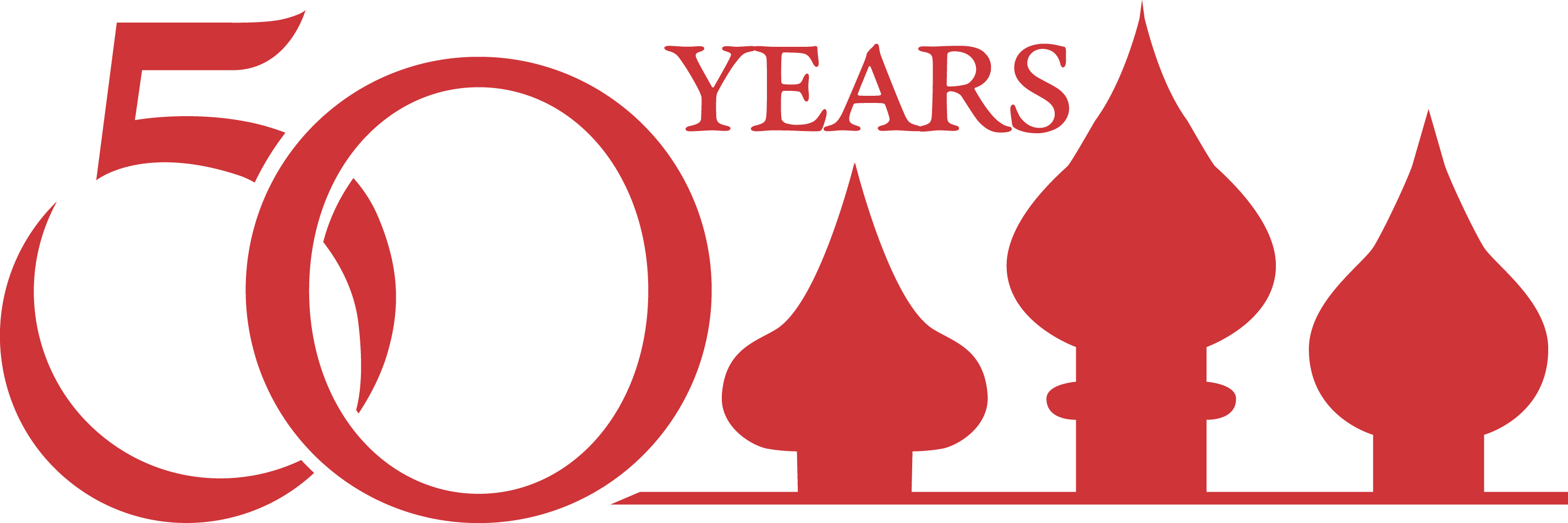
Kennan Institute
The Kennan Institute is the premier US center for advanced research on Eurasia and the oldest and largest regional program at the Woodrow Wilson International Center for Scholars. The Kennan Institute is committed to improving American understanding of Russia, Ukraine, Central Asia, the South Caucasus, and the surrounding region though research and exchange. Read more



